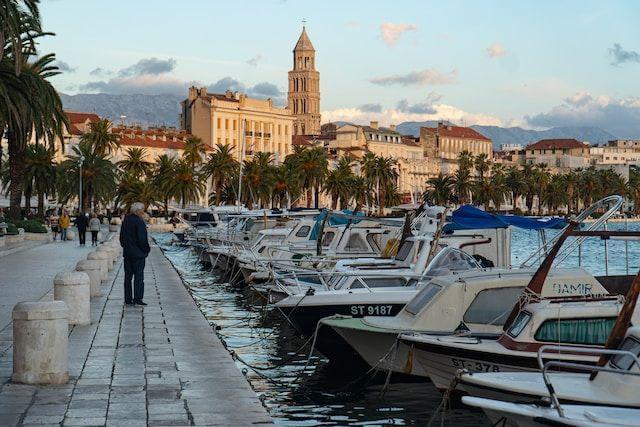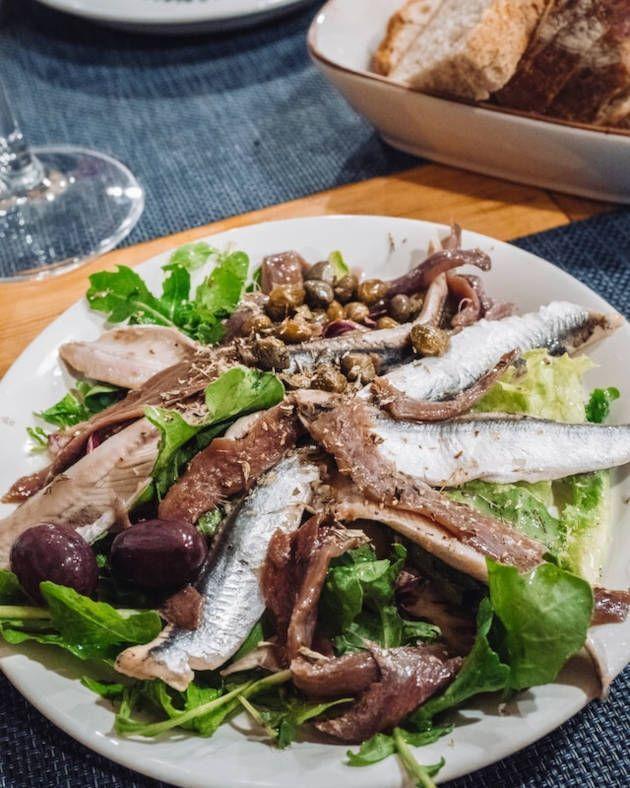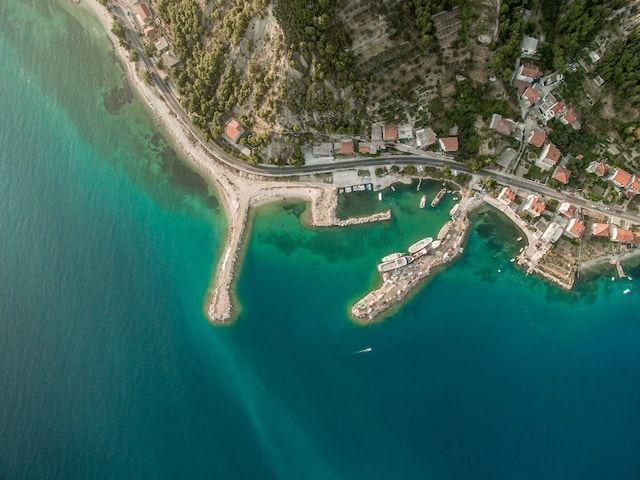Split Travel Guide: Notes to Explore Split
Split is a wonderful city both for its cultural historical heritage and for its natural beauty. In this Split travel guide you will find the necessary information to plan your trip.
General Information about Split
If you are thinking of taking a trip to Split, below you will find all the information you need so you don't miss a thing.
Split is a city located on the east coast of the Adriatic Sea, in the Dalmatia region of Croatia. It is the second largest city in Croatia, with a population of around 180,000 people.
The city is known for its historical and cultural heritage, including Diocletian's Palace, which was built in the 4th century AD and is now a UNESCO World Heritage Site.
Split is also a popular tourist destination that attracts visitors from all over the world for its sunny weather, beautiful beaches, and lively nightlife.
In addition to its cultural and natural attractions, Split is also a center for sports and recreation, with a variety of activities available, including sailing, kayaking, hiking, and cycling.
In turn, Split is an important economic and cultural center for the region, with a strong tradition of entrepreneurship and innovation. It is home to several universities and research institutions, as well as a thriving startup scene.

Seafront of Split
Picture of Avery Meeker on Unsplash
Location of Split
Below, we show you where is located Split:
Map of Split on Google Maps
Top 10 Places to Visit in Split
Split is a fascinating city thanks to its rich history and cultural treasures. Here we tell you some of the main places of interest in Split, so you can discover this charming Croatian city without missing a thing.
Diocletian's Palace
This ancient palace, built by the Roman Emperor Diocletian in the 4th century AD. C., is one of the most impressive historical monuments of Split. It is a UNESCO World Heritage Site and a major tourist attraction.
Cathedral of Saint Domnius
This beautiful cathedral, located within Diocletian's Palace, was originally built as a mausoleum for Diocletian himself. It is a significant example of Romanesque architecture and contains many valuable works of art.
Riva
This lively waterfront is a great place to take a stroll, enjoy a coffee or meal at one of the many cafes and restaurants, or watch the boats come and go.
Marjan Hill
This park and nature reserve is a popular place for hiking, jogging, and biking. It offers stunning views of the city, the sea and the surrounding islands.
Archeological Museum
This museum exhibits a wide range of ancient artifacts from the Split region, including Roman mosaics, sculptures, and inscriptions.
Peristyle Square
This beautiful square is located in the heart of Diocletian's Palace and is surrounded by impressive columns and ancient buildings.
Ethnographic Museum
This museum displays the cultural heritage of the Split region, including traditional clothing, tools, and household items.
Split City Museum
This museum tells the story of Split, from ancient times to the present day, through a collection of artifacts, documents, and multimedia exhibits.
Fish market
This lively market, located near the waterfront, is a great place to sample fresh seafood and local delicacies.
Ivan Mestrovic Gallery
This museum exhibits the works of Iván Meštrović, one of the most famous sculptors in Croatia, and is located in a beautiful villa overlooking the sea.
Eat and Drink in Split
Eating in Split is a great experience, because being a coastal city in Croatia, it has a cuisine strongly influenced by the sea and Mediterranean flavors.
Some typical Split foods are black risotto, Crni rižot, a dish made with squid ink, rice, onion, garlic and red wine, and octopus salad, Salata od hobotnice. This refreshing salad is made with cooked octopus, potatoes, onion, parsley and olive oil, a perfect appetizer or light lunch.
Also a typical dish is the peka. This traditional Croatian dish is made by slowly cooking meat (usually lamb, beef or chicken) and vegetables in a covered pot over hot coals. It is usually served with potatoes, often roasted in the same pot.
We also recommend you to try the grilled fish, Riblja plata. For this dish, fresh fish, often caught that day, is grilled and served with a side of vegetables and potatoes.
And of course, you must try the pašticada. This is a slow-cooked beef stew made with red wine, prunes, garlic, carrots, and other spices. It is often served with gnocchi or homemade pasta.
And a fabulous dessert is the fritule. These little donuts are a popular dessert in Split. They are made with flour, eggs, sugar, and raisins, and are often served dusted with powdered sugar.
As for the typical drinks, try the red wine, Crveno vino. Croatia is known for its excellent wines and the red wines produced in the Split region are no exception. Some of the most popular varieties include Plavac Mali, Dingač, and Postup.
Another option is Rakija, a traditional fruit brandy that is made from various fruits, including grapes, plums, and figs. It is often served as an aperitif or digestif, or Croatian beer, Hrvatsko pivo, as there are several locally produced beers in Croatia, including Karlovačko, Ožujsko and Tomislav.

Green leaves and fish salad
Picture of Chris Curry on Unsplash
The Cultural Identity of Split
The culture in Split is a mix of historical and contemporary influences, with a strong emphasis on Mediterranean and Dalmatian traditions.
The city has a rich history, dating back to Roman times, and this history is reflected in its architecture, art and cultural heritage, however, it is also open to the future, whereby the traditions of yesteryear are intermingled with the times that run harmoniously.
Local culture is also shaped by the city's coastal location, where fishing and boating play an important role in the local economy and way of life.
Also, one of the most prominent features of Split culture is its emphasis on family and community.
The family is considered the cornerstone of Croatian society, and this is reflected in the close-knit nature of the community in Split, and the people of Split are generally friendly, hospitable, and proud of their city and heritage.
The city is also known for its love of music, dance, and the arts. The Split Summer Festival, which takes place every year, is one of the oldest and most prestigious cultural events in Croatia and presents a wide range of music, theater and dance performances.
How to Get to Split
There are several ways to get to Split depending on your starting point. Here are some common options:
- By plane: Split has an international airport, which is located about 25 kilometers from the city center. There are direct flights to Split from many European cities, including London, Paris, Amsterdam and Frankfurt. From the airport, you can take a taxi, bus, or shuttle to the city center.
- By bus: Split is well connected to other Croatian cities and neighboring countries by bus. There are several daily bus routes from Zagreb, Dubrovnik, Zadar and other major cities. Buses are usually comfortable and affordable, and usually arrive at the Split bus station, which is located near the city center.
- By train: There is a train station in Split, but the train network in Croatia is not as developed as the bus network. There are several daily trains from Zagreb to Split, but the journey takes between 6 and 8 hours, and trains tend to be slower and less comfortable than buses.
- By car: If you are traveling from another part of Croatia or neighboring countries, driving to Split may be a good option. The main highway (A1) connects Split with Zagreb, and there are also good highways to Dubrovnik, Zadar, and other cities. Keep in mind that during the high season, the roads can be crowded and parking in the city center can be difficult.
How to Get Around in Split?
Getting around in Split is quite easy due to the large number of transportation options available.
- Walking: Split is a compact city, and many of its tourist attractions are located in the historic center, known as the Old Town (Diocletian). You can easily explore this area on foot, as the streets are pedestrianized and lined with shops, restaurants, and attractions.
- Bus: The bus system in Split is efficient and cheap. There are several bus lines that cover the city and its surroundings. You can buy tickets directly from the conductor or at ticket kiosks. Make sure you have cash in Croatian Kunas as they don't always accept credit cards.
- Taxi: Taxis are another option for getting around Split. You can find taxi ranks in several places in the city, such as the ferry terminal, the bus station and on the Riva (the promenade). Make sure the meter is on at the start of the trip or agree on a price before getting into the taxi.
- Bike: Split is a bike-friendly city, and there are several companies that offer bike rentals. You'll also find bike lanes in some areas. It is a fun and active way to explore the city and its surroundings.
- Scooter or Motorbike: Renting a scooter or motorbike is a popular option in Split. There are several rental companies in the city. However, keep in mind that traffic in Split can be heavy in certain areas, so make sure you have experience riding scooters or motorbikes before opting for this option.
- Ferry: If you want to explore the nearby islands, such as Hvar, Brac or Vis, you can take a ferry from the port of Split. There are several ferry companies that offer regular services to these islands, and also to destinations further afield like Dubrovnik.
Always remember to take into account the schedules and fares, and plan your trips in advance to make the most of your time in Split. Enjoy your visit!
Beaches of Split
Split is a beautiful coastal city in Croatia and is home to several stunning beaches that offer crystal clear waters and breathtaking views.
Here we tell you about some of the many stunning beaches that Split has to offer, whether you are looking for a lively atmosphere or a quiet place to relax.

Coast of Split
Picture of Grant Ritchie on Unsplash
Bacvice Beach
Bacvice Beach is the most popular beach in Split and is known for its crystal clear waters and lively atmosphere, as it is home to several restaurants, restaurants and nightclubs. The beach is located near the city center and is easily accessible by public transport.
Kasjuni Beach
Kasjuni Beach is a beautiful pebble beach located in the Marjan Forest Park. The beach is surrounded by lush vegetation, and the waters are calm and clear, making it a great place for swimming and sunbathing. There are also several restaurants and cafes nearby.
Bene Beach
Bene Beach is a family-friendly beach located on the eastern side of Marjan Hill. The beach has crystal clear waters and is surrounded by pine trees, which provide plenty of shade. There are several restaurants and cafes nearby, as well as children's play areas.
Znjan Beach
Znjan Beach is a long stretch of pebble beach located on the eastern side of Split. The beach is ideal for lovers of water sports, as there are several activities available, such as windsurfing and water skiing. The beach is also home to several restaurants and cafes.
Firule Beach
Firule Beach is a popular beach located near Bacvice Beach. The beach has crystal clear waters and is surrounded by pine trees, which provide plenty of shade. There are also several restaurants and cafes nearby.
When to Visit Split
The best time to travel to Split depends on your preferences, budget and travel plans. Here are some factors to consider:
- Climate: Split has a Mediterranean climate, with hot, dry summers and mild, rainy winters. The high tourist season is from June to September, when the weather is sunny and warm, and the sea is perfect for swimming. However, the summer months can also be very crowded and expensive, and temperatures can sometimes be too hot for some people. If you prefer milder weather and fewer crowds, consider visiting Split in the off-season (May, September, and October).
- Events and Festivals: Split hosts several events and festivals throughout the year, such as the Split Summer Festival (July and August), the Ultra Europe Music Festival (July) and the Split Film Festival (September). If you are interested in attending one of these events, please plan your trip accordingly.
- Budget: Prices for flights, accommodation and activities in Split may vary depending on the season. High season is usually the most expensive, and prices may be lower in the off-season. If you're traveling on a tight budget, consider visiting Split in the off-season (November to April), when prices tend to be lower.
- Activities: Split has many outdoor activities such as swimming, sunbathing, walking and cycling. The best time to enjoy these activities depends on your preferences. If you prefer swimming and sunbathing, the summer months are the best. If you prefer to hike and bike, the shoulder season or low season may be a good option, as temperatures are milder and crowds are smaller.
Festivals of Split
Split hosts a variety of festivals throughout the year that celebrate everything from music and film to culture and tradition. Here we present our top 10 festivals in Split:
Split Summer Festival
This is one of the oldest and most prestigious cultural events in Croatia, dating back to 1954. It takes place from mid-July to mid-August and features a wide range of music, theater and dance performances at various venues throughout the city. .
Ultra Europe
This is a three-day electronic music festival that takes place in July at the Poljud Stadium. It features some of the best DJs in the world and attracts a large number of visitors from all over the world.
Mediterranean Film Festival
This international film festival takes place in June and features a wide variety of feature films, short films and documentaries from the Mediterranean region and beyond.
Diocletian Days
This historical and cultural festival takes place in August and features re-enactments of ancient Roman life, as well as music, dance, and food.
Festival Ethnoambient Salona
This music festival takes place in July and August and features traditional and world music from various cultures around the world. It takes place in the ancient Roman city of Salona, which is located just outside of Split.
Flower Festival
This floral festival takes place in May and features a variety of flower shows, workshops, and performances throughout the city.
Split Boat Show
This nautical exhibition takes place in April and features a wide range of boats, yachts and other maritime equipment. It takes place at Marina Lav, which is located on the outskirts of Split.
Split Food Festival
This food festival takes place in October and showcases the best of local cuisine and wine. It features a variety of food and wine tastings, workshops, and cooking demonstrations.
Split Christmas Market
This Christmas market takes place in December and features a variety of Christmas crafts, foods, and decorations. It takes place in the historic city center and there are often Christmas carols and other seasonal performances.
Splitska Dica
This children's festival takes place in June and features a variety of games, contests and workshops for children. It is an excellent way for families to enjoy the cultural offer of the city together.
Destinations Near Split
Split stands out for its vibrant culture and its beautiful natural settings.
In turn, due to its proximity to Zagreb and Dubrovnik, many travelers combine their visit to Split with those destinations.
Are you looking to marvel at amazing beaches? Do you want to know a fascinating culture? Do you want to enjoy bars and clubs?
If your answer is "yes", at Greca we have several proposals for tourist packages to Split, which you can modify and adapt according to your needs and times.
There are travel packages for all tastes. Choose your own adventure according to your needs!
More Travel Guides!
If you have been interested in our Split travel guide and you want to continue learning about this and other wonderful destinations, we invite you to look at the section of all our Travel Guides. Plan your next adventure with Greca!